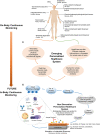Improving disease prevention, diagnosis, and treatment using novel bionic technologies
- PMID: 36684104
- PMCID: PMC9842045
- DOI: 10.1002/btm2.10359
Improving disease prevention, diagnosis, and treatment using novel bionic technologies
Abstract
Increased human life expectancy, due in part to improvements in infant and childhood survival, more active lifestyles, in combination with higher patient expectations for better health outcomes, is leading to an extensive change in the number, type and manner in which health conditions are treated. Over the next decades as the global population rapidly progresses toward a super-aging society, meeting the long-term quality of care needs is forecast to present a major healthcare challenge. The goal is to ensure longer periods of good health, a sustained sense of well-being, with extended periods of activity, social engagement, and productivity. To accomplish these goals, multifunctionalized interfaces are an indispensable component of next generation medical technologies. The development of more sophisticated materials and devices as well as an improved understanding of human disease is forecast to revolutionize the diagnosis and treatment of conditions ranging from osteoarthritis to Alzheimer's disease and will impact disease prevention. This review examines emerging cutting-edge bionic materials, devices and technologies developed to advance disease prevention, and medical care and treatment in our elderly population including developments in smart bandages, cochlear implants, and the increasing role of artificial intelligence and nanorobotics in medicine.
Keywords: bioelectronics; biointerfaces; materials; medical devices; tissue repair and regeneration; wearables.
© 2022 The Authors. Bioengineering & Translational Medicine published by Wiley Periodicals LLC on behalf of American Institute of Chemical Engineers.
Conflict of interest statement
The authors have no conflicts of interest to declare.
Figures





References
-
- National Institute of Aging UD of H and HS and the WHO . Global Health and Aging Report.
-
- He W, Goodkind D, Kowal P. US Department of Commerce, Economics and Statistics Administration
Publication types
LinkOut - more resources
Full Text Sources

